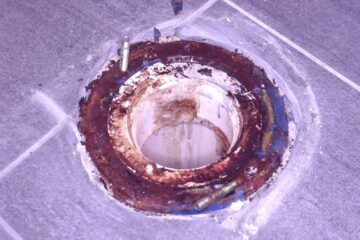Maintaining the pristine look of your black sink can be intimidating, as any slight blemish or scratch can stand out prominently. However, with the right techniques and products, you can keep your black sink looking polished and spotless. In this comprehensive guide, you will learn the most effective methods to clean and maintain a black sink, ensuring that it maintains its glossy and flawless appearance for years to come. From gentle cleaning solutions to preventive measures against scratches, this article will provide you with all the necessary steps to achieve a perfectly clean black sink.
Gather the Necessary Supplies
Before you begin cleaning your black sink, it’s important to gather all the necessary supplies. Here are the items you’ll need:
Rubber gloves
Rubber gloves are essential to protect your hands from any cleaning solutions or chemicals you may be using. They provide a barrier between your skin and potentially harsh substances.
Soft sponge or cloth
A soft sponge or cloth will be used to gently clean the surface of the sink. Avoid using abrasive materials that could scratch or damage the black finish.
Cleaning solution
Choose a cleaning solution specifically formulated for use on sinks. Look for one that is safe for black surfaces and effective at removing dirt and stains.
Baking soda
Baking soda is a versatile cleaning agent that can help remove tough stains and odors. It’s a gentle option for cleaning your black sink without causing any damage.
Vinegar
Vinegar is another effective natural cleaner that can help remove mineral deposits and stains. It’s a safe and eco-friendly option for cleaning your black sink.
Lemon juice
Lemon juice can be used to tackle rust stains in your black sink. Its acidic properties help break down rust and restore the sink’s appearance.
Toothbrush or cleaning brush
A toothbrush or small cleaning brush will be useful for scrubbing away stains in hard-to-reach areas of the sink. Choose one with soft bristles to avoid scratching the surface.
Microfiber cloth
A microfiber cloth is ideal for drying your black sink after cleaning. It’s soft and absorbent, leaving your sink streak-free and shiny.
Soft bristle brush
A soft bristle brush is essential for gently scrubbing away stains without damaging the black finish of your sink. This brush should be used with caution to avoid scratching the sink.
Paper towels
Paper towels will come in handy for various tasks, such as drying off your sink after rinsing or removing excess oil during the polishing process.
Preparing the Sink
To effectively clean your black sink, it’s important to properly prepare it. Follow these steps to ensure a successful cleaning process:
Remove any dishes or debris
Clear the sink of any dishes, utensils, or debris before you begin cleaning. This will give you a clear workspace and allow you to focus on the task at hand.
Rinse out the sink with warm water
Before you start using any cleaning agents, give your sink a thorough rinse with warm water. This will help remove any loose dirt or food particles.
Plug the drain
To prevent any cleaning solution from going down the drain prematurely, plug the sink drain with a stopper or drain cover. This will allow you to work directly on the sink’s surface without wasting any cleaning solution.
Wet the entire sink surface
Using warm water, wet the entire surface of the sink. This will help loosen any dirt or grime, making it easier to clean later on.
Basic Cleaning
Now that the sink is prepared, it’s time to start the basic cleaning process. Follow these steps to clean your black sink:
Apply a small amount of gentle soap or dish detergent
Squeeze a small amount of gentle soap or dish detergent onto a soft cloth or sponge. Avoid using harsh or abrasive cleaners that can damage the black finish of your sink.
Use a soft cloth or sponge to scrub the sink
Gently scrub the entire sink surface with the soapy cloth or sponge. Pay extra attention to areas that are stained or have accumulated dirt. Be thorough but gentle to avoid scratching the sink.
Rinse the sink thoroughly with warm water
After scrubbing, rinse the sink thoroughly with warm water. This will remove any soap residue and leftover grime. Ensure that all areas of the sink have been rinsed clean.
Dry the sink with a microfiber cloth
Using a clean microfiber cloth, dry the entire sink. This will prevent water spots and leave your black sink looking shiny and streak-free.
Removing Stains
If your black sink has stubborn stains that basic cleaning couldn’t remove, try these steps to tackle them:
Create a paste with baking soda and water
In a small bowl, mix baking soda with a small amount of water to create a paste. The consistency should be thick enough to adhere to the surface of the sink.
Apply the paste to the stained areas
Using a soft cloth or sponge, apply the baking soda paste directly onto the stains in your black sink. Make sure to cover the entire stained area with the paste.
Gently scrub the stains with a soft bristle brush
Using a soft bristle brush, gently scrub the stained areas in a circular motion. This will help lift and break down the stains without scratching the sink.
Rinse the sink well to remove any residue
Thoroughly rinse the sink with warm water to remove any residue from the baking soda paste. Ensure that all areas of the sink are rinsed clean.
Dry the sink with a microfiber cloth
Using a clean microfiber cloth, dry the sink to prevent any water spots or streaks. Be sure to give extra attention to the areas where the stains were located.
Removing Mineral Deposits
Mineral deposits can build up over time in your black sink, leaving unsightly marks. Follow these steps to remove mineral deposits:
Soak a cloth or sponge in vinegar
Pour vinegar into a small bowl and soak a soft cloth or sponge in it. Vinegar is an effective natural cleaner for removing mineral deposits.
Apply the vinegar-soaked cloth to the mineral deposits
Place the vinegar-soaked cloth or sponge on the areas with mineral deposits. Ensure that the entire affected area is covered with the vinegar-soaked cloth.
Let it sit for a few minutes to loosen the deposits
Allow the vinegar-soaked cloth to sit on the mineral deposits for a few minutes. The acidic properties of the vinegar will help loosen and dissolve the deposits.
Scrub the deposits gently with a toothbrush
After letting the vinegar sit, use a toothbrush with soft bristles to gently scrub the mineral deposits. Be careful not to apply too much pressure to avoid scratching the sink.
Rinse the sink thoroughly with warm water
Thoroughly rinse the sink with warm water to remove any remaining vinegar and loosened mineral deposits. Ensure that all areas of the sink are rinsed clean.
Dry the sink with a microfiber cloth
Using a clean microfiber cloth, dry the sink to prevent water spots and ensure a streak-free appearance. Pay extra attention to the areas where the mineral deposits were located.
Dealing with Rust Stains
Rust stains can make your black sink look aged and neglected. Follow these steps to remove rust stains effectively:
Sprinkle some lemon juice onto the rust stains
Sprinkle a generous amount of lemon juice directly onto the rust stains in your black sink. The acidic properties of lemon juice help break down rust.
Allow the lemon juice to sit on the stains for a few minutes
Allow the lemon juice to sit on the rust stains for a few minutes. This will give it time to penetrate the stains and break down the rust.
Scrub the stains with a soft bristle brush
Using a soft bristle brush, gently scrub the rust stains in a circular motion. The combination of lemon juice and gentle scrubbing will help lift and remove the rust.
Rinse the sink well with warm water
Thoroughly rinse the sink with warm water to remove any residue from the lemon juice and rust stains. Ensure that all areas of the sink are rinsed clean.
Dry the sink with a microfiber cloth
Using a clean microfiber cloth, dry the sink to prevent water spots and achieve a polished appearance. Be thorough in drying the areas where the rust stains were located.
Polish and Shine
To give your black sink a final touch and enhance its appearance, follow these steps to polish and shine it:
Apply a small amount of mineral oil or olive oil to a soft cloth
Pour a small amount of mineral oil or olive oil onto a soft cloth. These natural oils will help polish and protect the black finish of your sink.
Buff the sink surface with the oiled cloth
Gently rub the oiled cloth onto the entire surface of the sink. Use circular motions and apply even pressure to achieve a consistent shine.
Remove any excess oil with a paper towel
After buffing the sink, use a paper towel to remove any excess oil. This step ensures that your sink’s surface is not left overly greasy.
Polish the sink with a dry microfiber cloth
Using a clean and dry microfiber cloth, give the sink a final polish. This will remove any remaining streaks or smudges and leave your black sink looking impeccable.
Preventive Tips
To maintain the cleanliness and appearance of your black sink, here are some preventive tips to follow:
Clean your sink regularly
Make it a habit to clean your black sink regularly to prevent stains and buildup. This will help maintain its beautiful appearance and prolong its lifespan.
Avoid using abrasive cleaners or scrubbing pads
Avoid using harsh or abrasive cleaners and scrubbing pads that can scratch or damage the black finish of your sink. Stick to gentle cleaning solutions and soft brushes.
Use a sink grid or mat to protect the sink surface
Consider using a sink grid or mat to protect the surface of your black sink. These accessories can prevent scratches and minimize the risk of stains caused by pots, pans, or utensils.
Rinse and dry the sink after each use
After each use, rinse your black sink with warm water and dry it with a microfiber cloth. This will prevent water spots and keep your sink looking clean and shiny.
Avoid leaving standing water in the sink
Standing water can lead to mineral deposits and stains. Empty the sink promptly after use and ensure it is dry to prevent any unwanted buildup or discoloration.
Troubleshooting Common Issues
Sometimes, you may encounter common issues with your black sink. Here are some troubleshooting tips to address them:
Dealing with scratches
For minor scratches, try using a gentle abrasive cleaner or toothpaste. Apply the cleaner to a soft cloth and buff the scratched area in a circular motion. Rinse and dry the sink after.
9Removing stubborn stains
If basic cleaning methods haven’t removed stubborn stains, consider using a specialized stain remover designed for black sinks. Follow the instructions provided by the manufacturer for best results.
Restoring shine to a dull sink
If your black sink has lost its shine, try applying a small amount of baby oil or petroleum jelly to a soft cloth. Buff the sink surface with the oiled cloth to restore its luster.
Fixing chipped or damaged areas
For chipped or damaged areas, consult with a professional to assess the damage and recommend the appropriate repair or replacement options. Attempting DIY repairs may worsen the situation.
Removing hard water spots
Hard water spots can be treated with a mixture of equal parts white vinegar and water. Apply the solution to the affected areas, let it sit for a few minutes, then scrub gently and rinse.
Professional Maintenance
While regular maintenance can keep your black sink in great condition, sometimes professional help is necessary. Consider the following options for professional maintenance:
Hiring a professional cleaning service
If you prefer to leave the cleaning to the experts, consider hiring a professional cleaning service that specializes in sink maintenance. They have the knowledge and tools to effectively clean and restore your black sink.
Consulting with a specialist for complex problems
For complex issues such as severe damage or extensive staining, consult with a specialist who specializes in sink repairs or restoration. They can provide insights and recommend appropriate solutions.
Applying recommended sealants or coatings
Consult with professionals or sink manufacturers about recommended sealants or coatings for your black sink. These products can help protect the sink’s finish and extend its lifespan if applied correctly.
By following these comprehensive steps and tips, you can effectively clean and maintain your black sink, keeping it in pristine condition for years to come. Remember to always prioritize gentle cleaning methods to preserve the beauty of your sink and avoid any potential damage.



